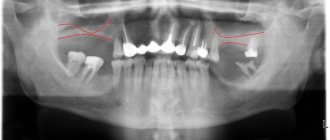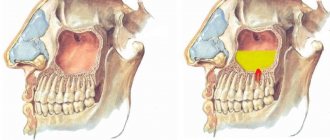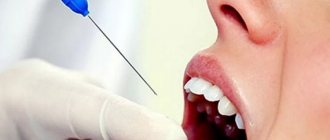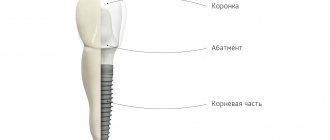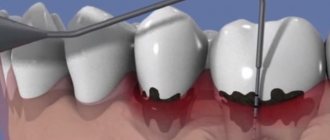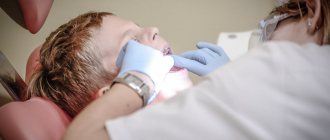From this article you will learn:
- how a sinus lift is performed – reviews, videos,
- open and closed sinus lifting – price for 2021,
- How can this operation be avoided?
A sinus lift is a surgical operation whose purpose is to increase the volume of bone in the bottom of the maxillary sinuses in the upper jaw. This operation is one of the options for bone grafting, and is sometimes necessary when installing dental implants in the lateral parts of the upper jaw. Most often this is necessary in the area of missing 5-6-7 teeth (i.e. molars and premolars).
The use of sinus lift during dental implantation is, as a rule, mandatory if the teeth in the lateral parts of the upper jaw were removed a long time ago, because in this case, the bottom of the maxillary sinus subsides in the area of missing teeth (Fig. 1). The implantologist’s task will be to raise the bottom of the maxillary sinus by grafting bone material, which can be done using one of two techniques - open or closed sinus lift.
What does raising the bottom of the maxillary sinus look like (diagram) -
Scheme of sinus lifting and implantation –
This article was written for patients and will allow you to navigate the pros and cons of the 2 main sinus lift techniques. We will also talk about several methods of dental implantation, which in some situations can make it possible to avoid the need for bone grafting altogether.
Why might you need a sinus lift?
If in other places where implants are installed, a lack of bone occurs due to periodontal diseases, traumatic removal and long-term absence of teeth, then in the lateral parts of the upper jaw this is due to anatomical features , and therefore concerns everyone.
The maxillary sinus (lat. sinus highmori) is a paired paranasal sinus that occupies almost the entire body of the maxillary bone.
Source: Wikipedia
The voids (sinuses) in the bones of the upper jaw are needed to generate sounds, warm the air entering the lungs and lighten the weight of the skull.
Materials for bone grafting
All types of materials used in sinus lifting can be divided into 3 types - autograft, xenograft and synthetic bone. Let us dwell in more detail on the features of each type.
Autograft
The best option for the procedure is the patient’s own bone – an autograft. A small piece is cut from the lower jaw or chin, then the material can be crushed and replanted while raising the floor of the maxillary sinus. The advantages of this approach are complete immune compatibility, i.e. the autograft takes root perfectly. But there are also disadvantages - sometimes a lot of material is required (which becomes traumatic for the patient, because after osteoplasty 2 operated areas will already heal). Disadvantages also include increased resorption of the autograft during the healing period; as a result, the patient sometimes requires repeated augmentation.
Previously, another type of natural material for osteoplasty was used - allograft. This substance is taken from a donor (most often cadaveric material is meant) and goes through several stages of processing and disinfection. The material is outdated due to unstable survival rate and ethical component.
Xenograft
Bone replacement materials of animal origin are obtained from bovine bone. The substance is crushed, sterilized and part of the impurities – collagen (or protein, protein) – are removed. The result is a substance that is sorted according to the diameter and shape of the particles - crumbs with a diameter of 0.25-1 mm, chips - from 1 to 2 mm, granules - from 4 to 6 mm. The crumbs can be pressed into blocks up to 3 cm long.
A large amount of proteins makes the material less dense, which reduces the fixation ability when installing an implant. It is considered optimal when the material contains at least 75-90% minerals, and the rest is collagen.
Xenografts have good survival rate and relatively low cost, so this type is often used in osteoplasty. After surgery, the material begins to interact with surrounding tissues. Gradually, your own young bone is formed, and the graft is absorbed. The following materials are widely used for augmentation: Swiss Bio-Oss from Geistlich Pharma and Russian Osteomatrix. Similar bone materials can be mixed with autografts.
Synthetic material
Synthetic bone has a complex mineral composition, presented in the form of granulate - medical two-phase calcium phosphate. It contains artificial crystalline hydroxyapatite and beta-3-calcium phosphate (an analogue of natural hydroxyapatite, which is the main building block of bone). The diameter of the granules is about 0.2-2 mm. After replanting, two-phase calcium phosphate is also gradually replaced by living young bone. Popular brands that have confirmed their high quality and biocompatibility are BoneCeramic from Straumann and Maxresorb from Botiss Dental.
Very often, along with augmentation, a PRF membrane (or PRF, PRP) is applied. This is a thick gel-like preparation obtained from the patient's own blood. The membrane contains a huge amount of fibrin protein, platelets and growth factors, which actively stimulate regeneration processes. This method will be a significant addition to osteoplasty, especially if large areas were operated on - this way the patient’s rehabilitation will be much faster and less painful.
Since we're going to do a sinus lift anyway... maybe we should wait?
The fact that this operation will most likely be required is not a reason to delay implantation.
In the absence of teeth, the jaw bone tissue, which has a predominantly porous structure, quickly dissolves. The size of the maxillary sinus also increases.
Such changes lead to the complication of the bone grafting operation, increase its cost, and the installation of implants and prosthetics will have to be postponed until the formation of new bone tissue.
We talk about this in detail in the article Insufficient volume and quality of bone tissue - contraindications to the installation of implants.
Contraindications to the procedure
Osteoplasty is not possible in the presence of acute immune diseases of the body (AIDS, HIV). Contraindications also include oncology, bleeding disorders, problems of the cardiovascular system, decompensated diabetes mellitus, too close to the bottom of the maxillary sinus (which makes it impossible to displace the membrane).
The presence of acute ENT diseases, caries or stomatitis are relative contraindications. Before surgery, it is imperative to completely cure a runny nose of any etiology (and constantly relieve allergic/medicinal rhinitis), as well as sanitize the oral cavity to minimize the risk of wound infection and other complications.
When is an Open Sinus Lift performed?
An open sinus lift is performed if you need to increase 8-10 millimeters of bone.
An open sinus lift is a more complex and traumatic operation since it is necessary to make a “window” directly into the maxillary sinus and, by lifting the bottom of the mucous membrane, fill the required volume with a bone substitute.
Are there any alternative solutions?
The need for a sinus lift does not arise in all cases. It will not be required if dental restoration is carried out using basal implantation technology, which uses a special type of implants.
There is no need for a sinus lift when using All-on-4 implantation technology. But there is one caveat: surgery according to this protocol is applicable only to patients with a completely toothless jaw.
Would you like to receive detailed advice on sinus lifting from qualified and experienced specialists? Come to an appointment with the doctors at our clinic in Moscow - “Aesthetica”! The initial consultation with a specialist is free and during the consultation you will receive detailed answers to all your questions about dental implantation.
To make an appointment, you just need to dial our clinic’s phone number or leave a request for a call back on our website.
Take a short test and calculate the cost of treatment!
Take a short test
- Selection of implants
- Which tooth is missing?
- How long has the tooth been lost?
- Missing teeth
- Cost calculation
×
Manukyan Artavazd Genrikovich
Chief physician of the clinic
Articles on the topic
What tests to take before dental implantation in Moscow
The necessary tests for dental implantation are determined individually after the initial examination.
The doctor takes into account the condition of the oral cavity and the presence of concomitant chronic diseases...... Read #dental implantation
Nobel implants – Nobel Biocare, turnkey price, reviews, installation
Nobel implants are developments of the Swiss manufacturer Nobel Biocare, celebrating their half-century anniversary.
Biocare is rightfully considered one of the leading implant manufacturers. Nobel products….. Read #dental implantation
Turnkey dental implantation: description of the procedure, features and benefits for patients
Implantation is a modern and effective method of restoring lost teeth.
During the operation, the patient is implanted in the area of the lost tooth with an implant - an artificial root, onto which it is then fixed..... Read #dental implantation
Implantation of chewing teeth: subtleties of the process, technology, prices
We will tell you about implantation of chewing teeth in this article.
After reading the material, you will learn about the features of implantation of chewing teeth, what implants and crowns are needed….. Read
Computer planning of surgery on a 3D model
Preparation for implant prosthetics begins with a computed tomography (CT) scan of the upper jaw.
A three-dimensional model created on the basis of a computed tomogram (CT) allows an orthopedic dentist and surgeon to assess bone volume and density, plan implant installation sites, and, if a sinus lift is necessary, assess the condition of the maxillary sinuses regarding their structure and ENT diseases.
Planning surgery using a computer model reduces the risk of complications.
Signature rehab to minimize swelling
For patients who want to get rid of facial swelling in 1-2 days, our Center has developed a set of restorative procedures
Recommendations in the postoperative period
Swelling may persist for 5–7 days after surgery.
- Blow your nose and cough carefully
- Don't drink liquids through a straw
- Eat soft foods
- Avoid air travel
- Avoid physical activity
- ...you will receive detailed recommendations from your dentist.
Do not worry. Sinus lift operations have been carried out for more than 30 years and doctors have accumulated sufficient experience to perform them successfully.
Share the link:
- Click here to share content on Facebook. (Opens in a new window)
- Click to share on WhatsApp (Opens in new window)
implantation, surgery topics: maxillary sinus, closed sinus lift, bone substitutes, implantation, bone grafting, bone grafts, open sinus lift, implant prosthetics, bone regeneration, sinus lift
What complications are there?
Among all the numerous possible options for an unfavorable outcome of the operation, we can distinguish specific complications (for example, perforation of the maxillary sinus) - characteristic specifically for sinus lift, and nonspecific (for example, bleeding) - those that sometimes occur after any surgical intervention.
It should be noted that symptoms such as pain, swelling and slight bleeding are not complications after sinus lift, but are caused by the body’s natural reaction to surgical intervention. They are inevitably present in the first few days after surgery and gradually subside.
If symptoms such as
- bleeding,
- incessant pain
- heat,
- nasal congestion and difficulty breathing,
this may indicate the onset of a complication and requires immediate consultation with a doctor.
Edema
Swelling is a common consequence of incisions and other tissue damage during surgery. Normally, swelling occurs immediately after surgery and subsides within 3 days. If swelling does not disappear after sinus lift, this is an alarming symptom in which you should definitely consult a doctor.
Pain
The question of how long it hurts after a sinus lift bothers many. In general, it is normal to experience pain after surgery as the anesthesia wears off. The reason why it hurts after sinus lift surgery is the physiological response of the body to microdamage to tissue and is a necessary element of the recovery process.
The pain is usually minor, but if it bothers you, you can take a pain reliever prescribed by your doctor. Normally, pain after a sinus lift gradually weakens and goes away within a week. The perception of pain is different for everyone, it is very individual, but in any case, a normally healing wound hurts less and less. If the pain does not subside, or even worsens, this means that you need to call a doctor.
Bleeding
On the one hand, bleeding is a natural and inevitable consequence of traumatic damage to small vessels during surgery. On the other hand, any bleeding is a potentially life-threatening situation. Of course, in the operating room there are all the means and capabilities to instantly stop bleeding, so the operation itself is often almost bloodless, especially if it is an operation such as a closed sinus lift, which is often combined with implantation.
There should be no bleeding from the nose after a sinus lift, but after the operation (mainly during the first two days), a small amount of blood or ichor may be released from the operation area in the mouth or from the nose. Therefore, to prevent such conditions or in case of minor bleeding immediately after the end of the operation, it is recommended to apply a cold compress to the cheek on the side where the operation was performed. And also bite a sterile swab or napkin at the operation site. The cold compress should not be kept for longer than 15-20 minutes and you should also wait 15-30 minutes before applying the compress again. If the bleeding does not stop, you should consult a doctor.
Infection
Infection can get into a surgical wound in several ways:
- violation of aseptic and antiseptic requirements during surgery (for example, a doctor may accidentally touch an area of mucous membrane with an instrument and not notice it, or a drop of saliva may accidentally enter the wound),
- refusal to take medications prescribed by a doctor during the postoperative period (including unintentional, for example, skipping the time of taking an antibacterial drug),
- the presence of sluggish untreated infections in the oral cavity or nasopharynx,
- entry of infection or bone material into the cavity of the maxillary sinus due to perforation of the mucosa,
- violation of oral hygiene during the rehabilitation period,
- wound injury and suture dehiscence,
- a serious decrease in immunity due to hypothermia, active sports, hard work or emotional stress.
The action of pathogenic microorganisms that penetrate the wound causes the development of inflammation. A sign of this is increased pain, increased swelling, increased redness of the tissue at the operation site, and the appearance of purulent discharge. Often there is also an increase in temperature (up to 38 degrees and above). In the future, the development of infection can lead to rejection of the implanted materials, serious illnesses (sinusitis) and other unpleasant consequences, so you cannot delay visiting a doctor if such symptoms appear.
Sinusitis
Inflammation of the paranasal sinuses (including the maxillary sinuses - sinusitis) occurs due to the penetration of a bacterial infection into the mucous membranes of the sinuses and can be either a consequence of infection of the damaged mucosa or a complication after a runny nose.
After a sinus lift, it will be better to make every effort not to catch a cold or illness, or to catch a respiratory infection, since this will not only create additional problems for the healing of sutures and tissue damage at the operation site (swelling, deterioration of ventilation of the nasal passages and sinuses, accumulation of mucus, coughing and sneezing, etc.), but will also weaken the immune system, slow down the engraftment of osteogenic material and recovery after surgery.
Sinusitis
Sinusitis is a type of sinusitis, inflammation of the maxillary sinuses, precisely those located at the site of the operation. As a complication after sinus lift, this disease can only occur if during the operation the sinus mucosa, the Schneiderian membrane, was damaged (for example, torn or punctured). Damage to it can lead to infection and the development of inflammation. Sinusitis not only can negate the whole point of the operation, but is also a dangerous disease in itself due to the proximity of the maxillary sinuses to the brain, and therefore requires serious and immediate treatment.
If the patient has sinusitis (which developed before surgery), it is impossible to perform a sinus lift. First, you need to undergo a course of antibacterial therapy, and only after that plan a sinus lift surgery.
Headache
This symptom may appear as a result of nerve irritation due to traumatic damage to the jaw tissue, or due to the toxic effects of infectious agents. It may occur due to developing sinusitis or other inflammatory reactions.
Headache can also occur due to emotional stress, when the patient is very afraid of the operation or fears complications. Pain can also be triggered by a surge in blood pressure, which often occurs after surgery in people prone to hypertension. Normally, the pain should not be severe, should be relieved with painkillers and non-steroidal anti-inflammatory drugs, which will be prescribed by the doctor in the postoperative period, and should resolve within 7 days after the operation. If the pain does not go away, and even more so if it intensifies, be sure to consult a doctor, as this may be a sign of wound infection, inflammatory reactions, and even rejection of bone material and implant.
Seam divergence
After the operation, the dissected soft tissues are sutured, i.e. stitches are placed so that the edges of the wound do not diverge and can heal normally, ensuring the integrity of the mucous membrane and other soft tissues and the normal functionality of the oral cavity.
The applied sutures are removed no later than 14 days after the operation, when the tissues have completely grown together. But sometimes (as after other operations) the stitches can come apart. In modern surgery, very strong and reliable materials are used, so sutures can come apart only for 2 reasons:
- violation of the rules of postoperative oral care,
- manufacturing defect of the thread.
Moreover, the second reason is extremely rare. Almost always, suture dehiscence occurs due to improper behavior of the patient - uncontrolled touching and rubbing the operation site with the tongue, traumatizing the wound with a hard toothbrush, eating solid foods (apples, nuts, etc.), excessive rinsing of the mouth, actions with great muscle tension (puffing). balloons, drinking drinks through a straw, loud singing, whistling, screaming, etc.
The result will be opening of the wound, bleeding and infection with the development of inflammation, which can lead to rejection of the implant or osteoplastic material. Therefore, at the first signs of suture dehiscence (pain, bleeding, increased swelling, sensation of moving protruding ends of threads or flaps of tissue in the wound area), you should immediately contact the clinic for medical advice and help.
Temperature
Low-grade fever (up to 37-37.5 degrees) in the first hours of the postoperative period can be considered normal, since this is often a physiological reaction of the body to surgery. But a prolonged and unexpected increase in temperature (especially when everything went well in the first day or two after sinus lift) is an alarming symptom and may be a sign of wound infection and incipient inflammation. In this case, you should immediately consult a doctor to inspect the oral cavity and the site of the operation. Timely measures taken can suppress the development of infection and ensure a successful outcome of the operation. And delaying and delaying will lead to complications and rejection of the implanted materials, which will negate the entire operation, and in some cases may even make it impossible to repeat the bone augmentation procedure and implantation.
Numbness
Loss of sensation after bone grafting in the upper jaw is much less common than during operations on the lower jaw. During the first 24 hours after the end of the operation, the anesthesia gradually wears off (usually within the first 12 hours, in rare cases a little longer) and sensitivity, as a rule, returns completely.
However, occasionally, loss of sensation may occur due to nerve damage during surgery, compression, or damage due to displacement of the bone material or implant. Correctly and fully carried out diagnostics (tomography) before the operation allows you to see the location (including atypical) of nerve branches and nodes, and therefore practically eliminates their accidental damage during sinus lifting.
In addition, the sensitivity of the upper jaw area is provided by several independent nerve branches and damage to one of them will not cause a complete loss of sensitivity.
However, in some cases, compression of the nerves is possible due to displacement of the implant (if it was installed simultaneously with a closed sinus lift), or pathological healing and proliferation of bone tissue. If numbness (complete or partial) appears a few days or even weeks after the procedure, you will have to contact the clinic to conduct a study and decide on further actions.
Fistula
A fistula is a pathological opening or passage that forms in the upper jaw between the oral cavity and the cavity of the maxillary sinus. This formation occurs as a result of an infection that destroys soft tissue and bone in a certain area. The reason in most cases is the penetration of pathogenic microorganisms into the postoperative wound due to violation of the dentist’s instructions - insufficient oral hygiene, chewing food on the side where the operation was performed, refusal (or negligence in carrying out) antibacterial therapy and antiseptic procedures.
Signs of the appearance of a fistula are an increase in temperature (up to 37-37.5 degrees), pain in the operation area when moving the head, a feeling of air moving in the mouth when breathing, the appearance of a hole in the upper jaw, and the discharge of pus from it.
The fistula will not disappear on its own, because... there is a hole in the bone in this place, so you will have to see a doctor.
Yield of bone material
Such a complication is possible in the first 14 days after surgery, until complete restoration and healing of all tissues has occurred. In cases where bone chips appear in the mouth or nose on the side of the operation, it is necessary to pay attention to the circumstances surrounding this (for example, playing sports) and the presence of other symptoms of complications (bleeding, suture dehiscence, etc.).
The release of bone material can occur due to its mobility and the appearance of holes in the materials covering it - during perforation of the mucous membrane of the maxillary sinus, or due to suture divergence.
As a result, osteogenic material may be washed out, which will neutralize the results of the operation and make it pointless, so it is necessary to report the problem to the doctor.
